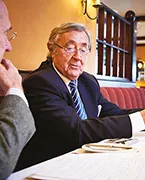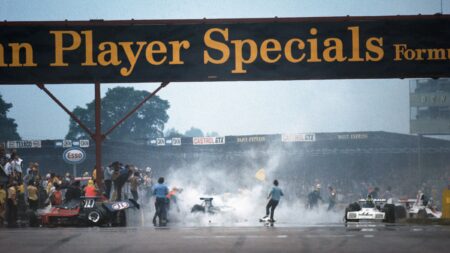Topp reckons it was more basic than that: “Despite its stumpy looks, WR1 was very aerodynamic.” In the early stages, Scheckter held the lead, and though Lauda outbraked him into the second chicane on lap 12 to take the lead, the Ferrari could not shake off its blue-and-gold shadow. Jody was just winding himself up for a victory challenge in the closing stages when, as he pitched hard into the Stadium section, he heard that horribly familiar cough, splutter, silence, restart. As he gently caressed the car to the finish and second place, he could be grateful for his first score in five grands prix. From a different perspective, however, it was the turningpoint in the title race. Scheckter was now more than a win behind Lauda in the points table, and The Rat’s Ferrari seemed awfully reliable.
“The fuel-feed problem only happened when the car got hot, and I think the fact that this was not allowing us to sort the car out was our big problem,” says Scheckter. ‘This issue went on for about six races and I think cost us the championship. But you could also say that, WI hadn’t made a couple of mistakes, things might have been different, too.”
Topp: “I’ve worked on the cars since then and I think it was all down to the collector pod in the fuel tank. When I built a new one, I copied the one out of a Williams FW07 and there was no problem. It’s easy to look back and see where we lost points.” Lauda, the scarred, cautious version, had been pretty much mistake-free in 1977, almost always finishing, usually on the podium. He was dauntingly x.-?
relentless — absolutely the last person you wanted to be facing while on the back foot Jody’s spinningaway of third place in Austria while lapping abackmarker in the closing stages, is testament to that.
By contrast, at Zandvoort, the Wolf was so far off the pace that Jody was almost relaxed by race-day; he kept his head and calmly made his way through the field to third place. On the top step of the podium, though, was… Lauda. The points table now read 63-42 in his favour, and Scheckter’s blown engine, while running second at Monza (Nilci finished second), virtually confirmed that the title would go to the Austrian. He finally secured it at Watkins Glen with a fourth; Jody was third. As a consolation, Wolf won the Canadian Grand Prix at Mosport, an emotional day for the team owner And though it was hugely lucky, Andretti retiring from the lead with just two laps to go, it thus neatly balanced the Long Beach disappointment



